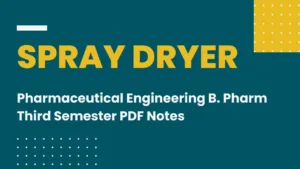Spray Dryer

Principle of Spray Dryer
The fluid to be dried is atomized into fine droplets, which are thrown radially into a moving stream of hot gas. Temperature of droplets is immediately increased & fine droplets get dried in the form of spherical particles. This process completes in few seconds before the droplets reach the wall of dryer
Construction of Spray Dryer
It consist of a large cylindrical drying chamber with a short conical bottom, made up of stainless steel. Diameter of 2.5- 9.0 meters & height 25.0 meters or more
• An inlet for hot air is placed in the roof of the chamber & another inlet carrying spray disk atomizer is set in the roof.
• Spray disk atomizer is about 300 mm in dia. & rotates at a speed of 3000 to 50,000 rpm. Bottom of the dryer is connected to a cyclone separator.
Working of Spray Dryer
Drying of material in spray dryer involves three stages;
a) Atomization of liquid
The feed is introduced through the atomizer either by gravity or by using suitable pump to form fine droplets. The properties of final product depends upon the droplet form. Atomizer can be of any type:
1. Pneumatic atomizer
2. Pressure nozzle type
3. Spinning disc atomizer
Rate of feed is adjusted in a such a way that droplets should be completely dried before reaching walls of drying chamber.
b) Drying of liquid droplets
• Surface of a liquid drop is dried immediately to form a tough shell. Liquid inside must escape by diffusing through the shell at a particular rate
• Heat transfer from outside to inside takes place at a rate greater than liquid diffusion rate. As a result, heat inside mounts up which allow the liquid to evaporate. This leads to increase in internal pressure, which causes droplets to swell
• The shells thickness decreases where as permeability for vapour increases. If the shell is neither elastic nor permeable it ruptures.
c) Recovery of dried product
• Centrifugal force of atomizer drives the droplet to follow helical path. Particles are dried during their journey & finally fall at the conical bottom
• All these processes are completed in a few seconds. Particle size of the final product ranges from 2 to 500 µm
• Particle size depends upon solid content of the feed, liquid viscosity, feed rate & disc speed
• Capacity of spray dryer – 2000 kg / h.
Advantages of Spray Dryer
1. It is continuous process & drying completes within 3 to 300 sec
2. Labour cost is low
3. Product of uniform & controllable size can be obtained
4. Fine droplets form provide large surface area for heat & mass transfer. Product shows excellent solubility
5. Either solution or suspensions or thin paste can be dried in one step to get final product ready for package
6. Drying of sterile product & Reconstituted product
7. Globules of an emulsion can be dried with the dispersed phase inside & layer of continuous phase outside
Disadvantages of Spray Dryer
1. It is very bulky & expensive
2. Such huge equipment is not always easy to operate
3. The thermal efficiency is low, as much heat is lost in the discharged gases
Uses of Spray Dryer
Spray dryers are used compulsorily, if:
1. The product is a better form than that obtained by any other dryer
2. The quantity to be dried is large
3. The product is thermolabile, hygroscopic or undergo chemical decomposition
A few product that are dried using spray dryer are:
Citric acid, Calcium, Sodium, Gelatin. sulphate
Also, Visit:
B. Pharma Notes | B. Pharma Notes | Study material Bachelor of Pharmacy pdf
